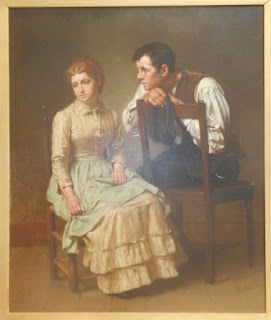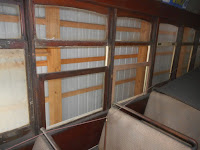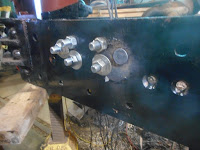News and views of progress at the Illinois Railway Museum
Thursday, August 31, 2017
Don't Take No for an Answer
Posted by
Randall Hicks
at
3:35 PM
0
comments
![]()
Labels: Shameless Prodding Division
Wednesday, August 30, 2017
Riveting News
Posted by
Randall Hicks
at
6:52 PM
1 comments
![]()
Labels: 18 Progress
Monday, August 28, 2017
Sunday report
Frank writes...
Sunday was something of a slow day at the museum. Rain was in the forecast, and while the sky looked threatening all day (and the crowd was commensurately small) we never got more than a few drops. I spent part of the afternoon in meetings and then did some work on Shaker Heights 18, doing more fitting work on the steel plate. Unfortunately, yet again I forgot to take any photos. Oops. But there was plenty of other stuff going on.
Richard, Greg, and Thomas were working on the CTA spam cans. One of the 6600s had an MG set that had failed and they dropped it out of the car. It sounds like it will need some components replaced but I didn't catch exactly what was wrong with it.
The step wells for CA&E 451, which I believe Fred and Jeff O. have been working on, were out in Barn 4 in primer.
And then there's the progress that's been made recently on Illinois Terminal Class B 1565. Above, the new control resistors that were specially modified to specifications developed by Bob Sundelin have arrived. Installation of these should make the locomotive operational again.
And in the meantime, windows for the 1565 are being refurbished and are in the "lean-three" in fresh Tile Red.
Posted by
Frank Hicks
at
7:18 PM
0
comments
![]()
Saturday, August 26, 2017
Saturday Report
Posted by
Randall Hicks
at
7:43 PM
6
comments
![]()
Wednesday, August 23, 2017
Help Wanted
Posted by
Randall Hicks
at
8:33 AM
0
comments
![]()
Us and Them....
David writes .....


Posted by
David Wilkins
at
7:04 AM
0
comments
![]()
Tuesday, August 22, 2017
A Hole in the Sky
Posted by
Randall Hicks
at
6:19 PM
0
comments
![]()
Labels: Trip Reports
Monday, August 21, 2017
Elevate your mind
Frank writes...
My wife and I just got back from the St. Louis area, where we went to see the eclipse. But more on that later. On the way down on Sunday, we stopped at the J.H. Hawes Elevator Museum in Atlanta, Illinois. I'm not certain how many grain elevators are preserved as museums but it's not very many. This one is very nicely done but unfortunately it's only open two hours a week, 1pm-3pm on Sundays. Lucky for us we finagled our schedule to make it work! Admittedly, this is only tangentially related to trains, but you may find it interesting anyway. If not, you'll get a full refund.
It's located along the abandoned ROW of the Pennsy (Vandalia Railroad) Terre Haute-to-Peoria line and a 40' outside-braced radial-roof boxcar dating to 1927, 47194, is on display adjacent to the structure. The boxcar was just recently repainted and hadn't yet been lettered when we were there.
The engine house has a contemporary gas engine installed in it. To reduce the risk of explosions, always a serious concern in grain elevators, engines were placed in separate buildings. This engine is still fully operational, as is the elevator itself.
The grain leg inside the elevator is driven through a shaft that goes from the engine house into the basement of the elevator itself. The first floor of the elevator is probably 5' off the ground, give or take.
Looking into the carriage bay (?) of the elevator from the doorway visible in the first photo, you can see how grain was brought in. A cart, such as the one shown, would be driven in after being weighed and would be spotted in a tilting bed. The cart would then be tilted, the grain would be poured through a trapdoor (foreground) into a bin in the basement of the elevator, and then would be hoisted up the leg (through one of those doorways to the left of the cart) to the distributor at the top where it would be deposited into one of nine bins located in the elevator's interior.
A slightly better view of the cart tilting mechanism. There's very little steel in the elevator structure itself (other than the leg and distributor mechanisms) with the exception of tie rods through the structure to keep the weight of the grain from bowing the walls outwards; these can be seen on the wall to the right as well as on the exterior of the elevator.
Here we are standing next to the cart looking through one of those doorways from the carriage bay into the interior of the elevator; through the doorway straight ahead is the door of the Wabash boxcar. In the right foreground are the two sides of the grain leg, with some of the wooden panels replaced by Plexiglas to show the steel buckets that are attached to the leather strap to make up the hoist. Beyond it is an open area just inside from where they would spot boxcars; overhead in this spot is a bin fitted with a scale where grain to be shipped out would be weighed. The grain would be poured from its bin into the basement; lifted up the leg to the top of the elevator; routed via the distributor to the weighing bin; weighed; poured back into the basement; lifted up the leg again; and routed via the distributor to a chute into the boxcar. The entire thing functions through gravity and a single grain leg.
Here's the view looking straight up the elevator. At upper right are the ropes that drive the leg at top and bottom; the pulley visible nearest the camera just hangs, with a weight suspended, and acts as the tensioning device. To the left is the weighing bin and at the bottom of the photo are the stairs to the top, unfortunately but understandably off-limits to visitors.
So now that grain elevator class is concluded, it's on to the eclipse. We had planned to view it from the vicinity of Marthasville, Missouri, some 50 miles west of St. Louis along the north side of the Missouri River. Little did I know that Marthasville was along the MKT, now abandoned and known as the Katy Trail. I did snap the below photo of a shelter built along the trail; unfortunately I neglected to get a picture of the depot, fixed up and standing nearby as the chamber of commerce! What would Dave's Depots say?
Oh well, the eclipse was still awfully cool. The photo below was taken at 1:16pm, about an hour after the above photo, during the brief period of total eclipse.
Posted by
Frank Hicks
at
10:22 PM
2
comments
![]()


















































